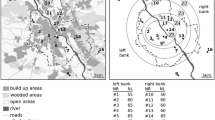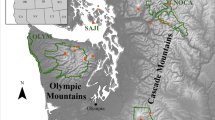Abstract
The German cockroach is one of the world’s most widespread invasive species. From uncertain origins, it appears in historical records in Europe over 300 years ago, with the first records in China date from 100 years ago. Since the 1990s, the German cockroach has dominated indoor environments across China. A genetic analysis of 599 individuals from nine cities across China found two genetic clusters; one dominant in the North and the other dominant the in South of the country. Weak but significantly positive isolation by distance was observed for the entire country; however, when broken into different geographical scales, the significantly positive correlation can be only observed in between cities or city to suburb range (10–221 km). Two factors may have contributed to the spread of the German cockroach in China, which correspond to these two clusters: central heating systems in the north built during the 1960s, and air-conditioning systems in the south built during in the 1990s. The spread of modern, long distance transport systems, such as railways, may have contributed to the lack of geographic patterns, yet it is likely that other factors have been important in determining patterns.




Similar content being viewed by others
References
Ascunce MS, Yang CC, Oakey J, Calcaterra L, Wu WJ, Shih CJ, Shoemaker D (2011) Global invasion history of the fire ant Solenopsis invicta. Science 331(6020):1066–1068
Booth W, Bogdanowicz SM, Prodöhl PA, Harrison RG, Schal C, Vargo EL (2007) Identification and characterization of 10 polymorphic microsatellite loci in the German cockroach, Blattella germanica. Mol Ecol Notes 7(4):648–650
Booth W, Santangelo RG, Vargo EL, Mukha DV, Schal C (2010) Population genetic structure in German cockroaches (Blattella germanica): differentiated islands in an agricultural landscape. J Hered 102(2):175–183
Cloarec A, Rivault C, Cariou ML (1999) Genetic population structure of the German cockroach, Blattella germanica: absence of geographical variation. Entomol Exp Appl 92(3):311–319
Cornwell PB (1968) The cokroach. The Rentokil Library, London
Crissman JR, Booth W, Santangelo RG, Mukha DV, Vargo EL, Schal C (2010) Population genetic structure of the German cockroach (Blattodea: Blattellidae) in apartment buildings. J Med Entomol 47(4):553–564
Dray S, Dufour AB (2007) The ade4 package: implementing the duality diagram for ecologists. J Stat Softw 22(4):1–20
Earl DA (2012) STRUCTURE HARVESTER: a website and program for visualizing STRUCTURE output and implementing the Evanno method. Conserv Genet Resour 4(2):359–361
Evanno G, Regnaut S, Goudet J (2005) Detecting the number of clusters of individuals using the software STRUCTURE: a simulation study. Mol Ecol 14:2611–2620
Fitzpatrick BM, Fordyce JA, Niemiller ML, Reynolds RG (2012) What can DNA tell us about biological invasions? Biol Invasions 14(2):245–253
Gu Q, Zhang M, Zhou C, Zhu G, Dong J, Gao Y, Chen P et al (2015) Analysis of genetic diversity and population structure of Bellamy aquadrata from lakes of middle and lower Yangtze River. Genetica 143(5):545–554
Guichoux E, Lagache L, Wagner S, Chaumeil P, Léger P, Lepais O, Petit RJ et al (2011) Current trends in microsatellite genotyping. Mol Ecol Resour 11(4):591–611
Guillemaud T, Ciosi M, Lombaert E, Estoup A (2011) Biological invasions in agricultural settings: insights from evolutionary biology and population genetics. C R Biol 334(3):237–246
Guillot G, Renaud S, Ledevin R, Michaux J, Claude J (2012) A unifying model for the analysis of phenotypic, genetic, and geographic data. Syst Biol sys038
Huang Y, Zhang WG (2010) Efficacy of baits to cockroach in the passenger liner. ZhonghuaWeishengShachongYaoxie 2:10 (Written in Chinese)
Huang Q, Li G, Husseneder C, Lei C (2013) Genetic analysis of population structure and reproductive mode of the termite Reticulitermes chinensis Snyder. PLoS ONE 8(7):e69070
Jakobsson M, Rosenberg NA (2007) CLUMPP: a cluster matching and permutation program for dealing with label switching and multi-modality in analysis of population structure. Bioinformatics 23:1801–1806
Leberg PL (2002) Estimating allelic richness: effects of sample size and bottlenecks. Mol Ecol 11(11):2445–2449
Lee CE (2002) Evolutionary genetics of invasive species. Trends Ecol Evol 17(8):386–391
Jobet E, Durand P, Langand J, Muller-Graf CD, Hugot JP, Bougnoux ME, Rivault C, Cloerec A, Morand S (2000) Comparative genetic diversity of parasites and their hosts: population structure of an urban cockroach and its haplodiploid parasite (oxyuroid nematode). Mol Ecol 9:481–486
Lian W, Zhou J, Zhou Q, Qiu C, Xu Y (1960) Investigation of cockroaches in transportation system. DongwuxueZazhi p 222–226 (Written in Chinese)
Linnaeus C (1767) Systemanaturae, 12 edn, vol 2. Salvii, Holmiae, p 688
Lombaert E, Guillemaud T, Cornuet JM, Malausa T, Facon B, Estoup A (2010) Bridgehead effect in the worldwide invasion of the biocontrol harlequin ladybird. PLoS ONE 5(3):e9743
Oksanen J, Blanchet FG, Kindt R, Legendre P, Minchin PR, O’Hara RB, Oksanen MJ (2015) Package ‘vegan’. Community ecology package, version 2.3-0. Accessed Oct 2015
Oosterhout C, Hutchinson WF, Wills DP, Shipley P (2004) MICRO-CHECKER: software for identifying and correcting genotyping errors in microsatellite data. Mol Ecol Notes 4(3):535–538
Owens JM, Bennett GW (1982) German cockroach (Orthoptera, Blattellidae) movement within and between urban apartments. J Econ Entomol 75:570–573
Peakall R, Smouse PE (2012) GenAlEx 6.5: genetic analysis in Excel. Population genetic software for teaching and research-an update. Bioinformatics 28:2537–2539
Peng X (1987) Demographic consequences of the Great Leap Forward in China’s provinces. Popul Dev Rev. 13(4):639–670
Piccinali RV, Gürtler RE (2015) Fine-scale genetic structure of Triatoma infestans in the Argentine Chaco. Infect Genet Evol 34:143–152
Pritchard JK, Stephens M, Donnelly P (2000) Inference of population structure using multilocus genotype data. Genetics 155(2):945–959
Rehn JAG (1945) Man’s uninvited fellow traveller—the cockroch. Sci Mon 61:265–276
Rivault C (1989) Spatial distribution of the cockroach, Blattella germanica, in a swimming-bath facility. Entomol Exp Appl 53(3):247–255
Roth LM (1985) A taxonomic revision of the genus Blattella Caudell (Dictyoptera, Blattaria, Blattellidae). Entomologica Scandinavica, Lund
Rousset F (2008) GENEPOP’007: a complete re-implementation of the genepop software for Windows and Linux. Mol Ecol Resour 8:103–106
Rust MK, Owens JM, Reierson DA (1995) Understanding and controlling the German cockroach. Oxford University Press, New York
Saenz VL, Booth W, Schal C, Vargo EL (2012) Genetic analysis of bed bug populations reveals small propagule size within individual infestations but high genetic diversity across infestations from the eastern United States. J Med Entomol 49(4):865–875
Saw J, Endersby NM, Mckechnie SW (2006) Low mtDNA diversity among widespread Australian diamondback moth Plutella xylostella (L.) suggests isolation and a founder effect. Insect Sci 13(5):365–373
Schuelke M (2000) An economic method for the fluorescent labelling of PCR fragments. Nat Biotechnol 18(2):233–234
Shapiro JR (2001) Mao’s war against nature: politics and the environment in revolutionary China. Cambridge University Press, Cambridge
Sowerby A (1930) The naturalist in Manchuria 5. Tientsin Press Limited, Tientsin, p 192
Vargo EL, Crissman JR, Booth W, Santangelo RG, Mukha DV, Schal C (2014) Hierarchical genetic analysis of German cockroach (Blattella germanica) populations from within buildings to across continents. PLoS ONE 9(7):e102321
Wagner CE, Keller I, Wittwer S, Selz OM, Mwaiko S, Greuter L, Seehausen O (2013) Genome-wide RAD sequence data provide unprecedented resolution of species boundaries and relationships in the Lake Victoria cichlid adaptive radiation. Mol Ecol 22(3):787–798
Wang X, Mo J (2009) Infestation and related research of the German cockroach in China. Urban pest control. 2:3–8 (Written in Chinese)
Wei SJ, Shi BC, Gong YJ, Jin GH, Chen XX, Meng XF (2013) Genetic structure and demographic history reveal migration of the diamondback moth Plutella xylostella (Lepidoptera: Plutellidae) from the Southern to Northern Regions of China. PLoS ONE 8(4):e59654
Wilson GA, Rannala B (2003) Bayesian inference of recent migration rates using multilocus genotypes. Genetics 163(3):1177–1191
Woo F, Guo Y (1984) The specific identification, distribution, bionomics and economic importance of the genus Blattella Caudell (Blattaria: Blattidae) from China. Kun Chong XueBao. 27:439–443 (Written in Chinese)
Xin JJ, Shang QL, Desneux N, Gao XW (2014) Genetic diversity of Sitobion avenae (Homoptera: Aphididae) populations from different geographic regions in China. PLoS ONE 9(10):e109349
Yang XM, Sun JT, Xue XF, Li JB, Hong XY (2012) Invasion genetics of the western flower thrips in China: evidence for genetic bottleneck, hybridization and bridgehead effect. PLoS ONE 7(4):e34567
Zheng Y, Peng X, Liu G, Pan H, Dorn S, Chen M (2013) High genetic diversity and structured populations of the oriental fruit moth in its range of origin. PLoS ONE 8(11):e78476
Acknowledgments
For providing samples, we thank Tan Eng Kooi, Bayer Singapore, Singapore; Wu Xifeng, Shenyang; Mr. Nan, Sinopest Co. Ltd, Beijing; Wang Jiansheng, Best Pest Control Co. Ltd., Nanjing; Mo Yuan, Chongqing; Pan Qiang, Huaguan Pest Control Co. Ltd., Guangzhou. This work is supported by NUS (National University of Singapore, Singapore) Research Scholarship from Ministry of Education, Singapore and the Lee Hiok Kwee Endowed Fund of the Department of Biological Sciences, National University of Singapore, Singapore. Thomas Bourguignon was supported by a postdoctoral fellowship from the University of Sydney.
Author information
Authors and Affiliations
Corresponding author
Ethics declarations
Conflict of interest
The authors declare that they have no conflict of interest.
Electronic supplementary material
Below is the link to the electronic supplementary material.
Rights and permissions
About this article
Cite this article
Tang, Q., Jiang, H., Li, Y. et al. Population structure of the German cockroach, Blattella germanica, shows two expansions across China. Biol Invasions 18, 2391–2402 (2016). https://doi.org/10.1007/s10530-016-1170-x
Received:
Accepted:
Published:
Issue Date:
DOI: https://doi.org/10.1007/s10530-016-1170-x




